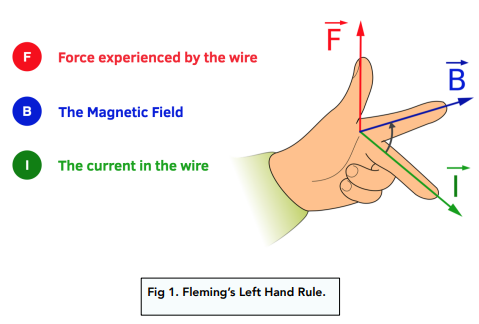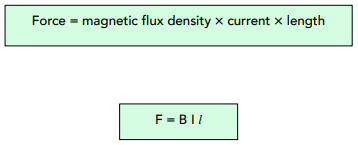Fleming's Left Hand Rule (GCSE Physics)
Fleming’s Left Hand Rule
The Motor Effect
- A current-carrying wire creates a magnetic field. We can place this wire into another magnetic field. This causes the two magnetic fields to interact.
- When they interact, the fields exert forces on each other. The wire exerts a force on the field and the field exerts a force on the wire. This is known as the motor effect.
- As it exerts a force, the motor effect can cause the wire to move. The force experienced by the wire is strongest when it is placed at 90 degrees to the existing magnetic force.
Using Fleming’s Left Hand Rule
You can predict the direction of the force-motion effect from Fleming’s left-hand rule.
- The thumb represents the direction the force acts.
- The first finger represents the direction of the magnetic field.
- The second finger represents the direction of the convention current.

Factors Affecting Force on Conductor
There are three main factors that affect the size of a force on a conductor:
- Current: The larger the current, the larger the force.
- Length: The longer the length of the conductor, the larger the force.
- Magnetic Flux Density: The higher the density, the more magnetic field lines and the larger the force on the conductor.
Linking Force and Flux Density
The force experienced by a wire in a magnetic field can be calculated using the equation below.
For exams, you need to be able to remember and use the following equation.

Where:
- force, F, in newtons, N
- magnetic flux density, B, in tesla, T
- current, I, in amperes, A (amp is acceptable for ampere)
- length, l, in metres, m
Question: Calculate the force generated when the magnetic flux density is 5T, the current is 30 000 milliamps and the length of wire is 100cm.
1. Get the correct units.
If you don’t convert correctly, the answer may be out by a factor of 100+
Current should be in amps so 30 000 milliamps = 30 amps
Length should be in metres so 100 cm = 1m
2. Substitute in the numbers.
F = B I l
F = 5 x 30 x 1
F = 150 Newtons
FAQs
Fleming’s Left Hand Rule is a rule used in physics to determine the direction of the force experienced by a current-carrying conductor in a magnetic field.
To use the Left Hand Rule, you extend your thumb, first finger, and second finger in a straight line, perpendicular to each other. Your thumb represents the direction of the magnetic field, your first finger represents the direction of current flow, and your second finger represents the direction of the force experienced by the conductor.
Fleming’s Left Hand Rule is used in a variety of electrical and electromechanical systems, such as electric motors, generators, and transformers, to determine the direction of the force experienced by a current-carrying conductor in a magnetic field.
The Left Hand Rule is important in physics because it helps to explain how electric currents interact with magnetic fields, which is the basis of many electrical and electromechanical systems. Understanding this interaction is crucial for designing and analyzing these systems.
Yes, there is also a Right Hand Rule that can be used to determine the direction of the force experienced by a current-carrying conductor in a magnetic field. The Right Hand Rule is simply the mirror image of the Left Hand Rule and can be used interchangeably, depending on personal preference.
The direction of the force experienced by a current-carrying conductor in a magnetic field is perpendicular to both the direction of the current and the direction of the magnetic field. The direction of the force can be determined using either the Left Hand Rule or the Right Hand Rule.
In an electric motor, a current-carrying conductor is placed in a magnetic field, causing a force to be experienced by the conductor. The direction of this force can be determined using the Left Hand Rule, and it causes the conductor to rotate. This rotation is used to drive the operation of the electric motor.
No, the Left Hand Rule is used to determine the direction of the force experienced by a current-carrying conductor in a magnetic field. To determine the direction of the magnetic field, a compass or other magnetic field sensor can be used.
In a generator, a rotating conductor is placed in a magnetic field, causing a current to flow in the conductor. The direction of this current can be determined using the Left Hand Rule, and it provides the electrical power output of the generator.
No, the Left Hand Rule is used to determine the direction of the force experienced by a current-carrying conductor in a magnetic field. To determine the direction of the current in a circuit, you can use Ohm’s Law, Kirchhoff’s Laws, or other electrical laws and principles.





Still got a question? Leave a comment
Leave a comment